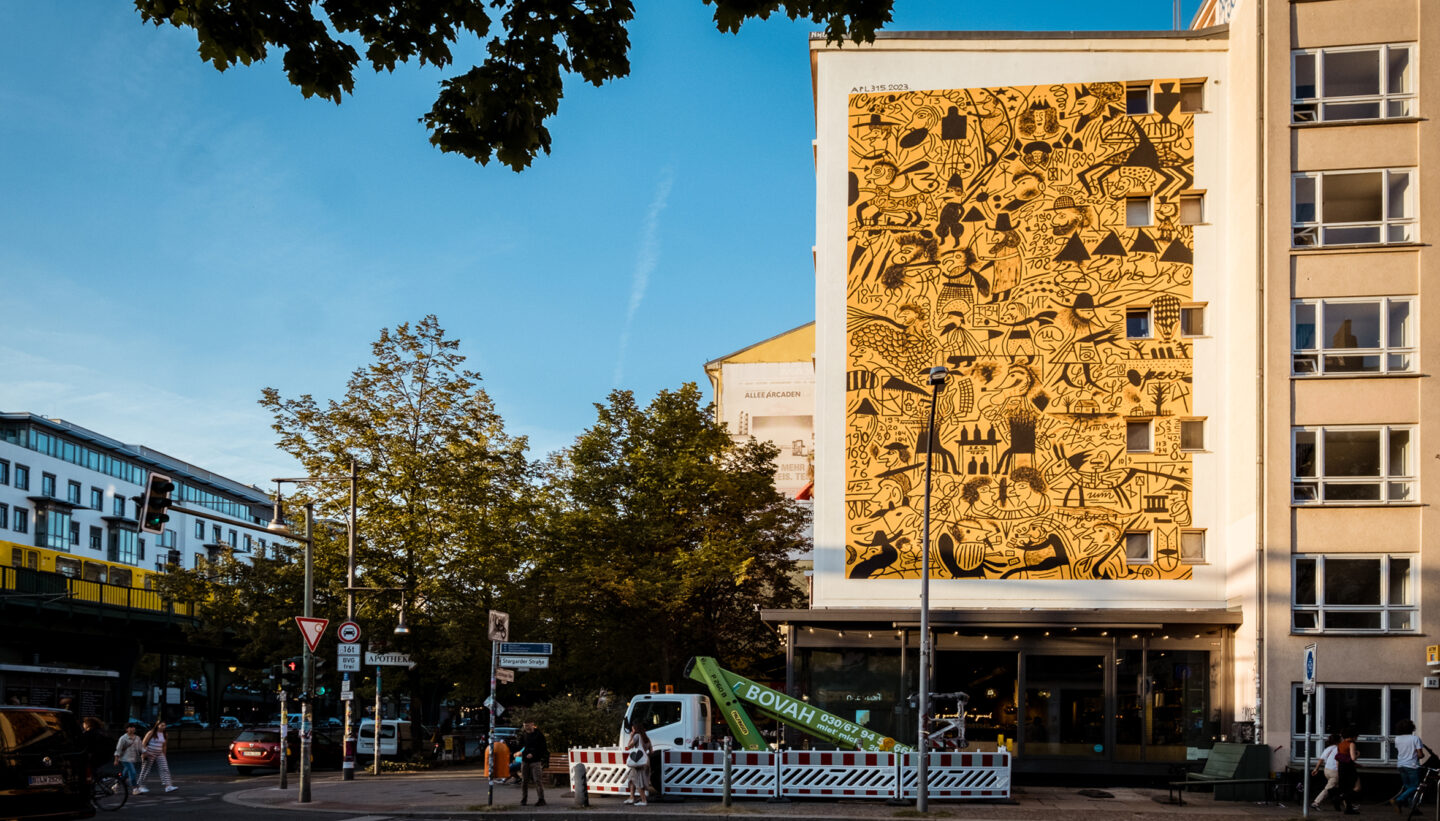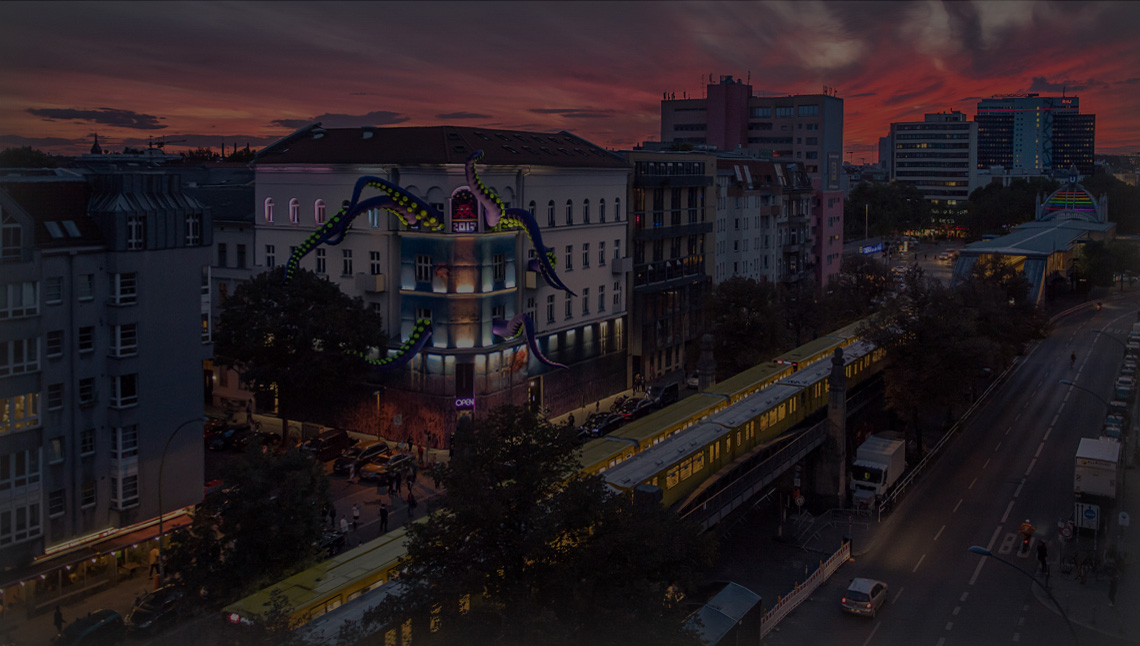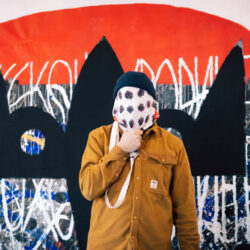
ONE WALL BY Apl315 | Fresh A.I.R.
- ARTIST IN RESIDENCE
- Fresh A:I:R
- Fresh A.I.R. #8
- ONE WALL
- September 21, 2023
Writings on the Wall. About the wall painting by Apl315
With the latest wall design in Prenzlauer Berg on the corner of Stargarder Straße/Schönhauser Allee, the second One Wall by a Fresh A.I.R. fellow has now been implemented. The Ukrainian artist Apl315 created a sort of large-format picture puzzle within a week, which combines wall scribbles and notes from his hometown Odessa with his temporary home Berlin on several levels.
The mural is a tribute to the mysterious past of the so-called Odessa Catacombs, an approximately 2,500-kilometer-long tunnel system created in the 19th century that extends beneath Odessa and far into the outskirts of the Ukrainian city of millions on the Black Sea. It was formed by the quarrying of pontic limestone, mainly used for housing, which began in the late 18th century and continued until the mid-20th century (Yavorska et al. (2018)).
The basis of the mural in Prenzlauer Berg are drawings and inscriptions from the time of the catacombs between 1840 and 1917, and are thus partly over 100 years old. Apl315 conducted extensive research on site in the years before the outbreak of the Russian war against Ukraine and meticulously photo-documented the images and inscriptions, most of which were drawn with charcoal. They are mainly from people who worked in the sandstone mines and predominantly exhibit a naïve style.
On the walls, workers and soldiers have left work-related notes and mathematical equations next to mythical creatures, handprints next to mundane figurative drawings from the everyday world of working people at that time, as well as humorous illustrations that surely contributed to the general amusement during a break. In the spirit of Appropriation Art, Apl315 has created a picture puzzle-like collage based on those pictorial-textual legacies that beckons to be discovered. In this way, the artist also refers to the history of Prenzlauer Berg as a former working-class neighborhood. He combines the sooty black of the charcoal drawings with a hue that on the one hand refers to the brewery and industrial buildings in the district built with yellow brick and on the other picks up on the color of the older A3 subway trains that can still be seen running over the viaduct of the U2 line along Schönhauser Allee from time to time.
“Historical Graffiti” as Visual Sources of Everyday Culture
The meticulous exploration of the Odessa catacombs began in 1846 with the work of the Finnish paleontologist Alexander von Nordmann. Nordmann and his colleagues from other scientific fields focused on mapping and geological exploration. For ancient historians, ethnologists, and philologists, these so-called historical graffiti are considered valuable sources: In the Roman city of Virunum, for example, it was possible to reconstruct the recording of business transactions thanks to the graffiti (Gostencnik 2018), and from Pompeii, in addition to greetings, self-reflexive jokes, and attendance notes, erotic graffiti are also known to provide information about the conditions of sex work at the time (Weeber (2019), Lohmann (2018)).
The mural by Apl315 – Memorial and Reminder
The mural at the corner of Stargarder Straße/Schönhauser Allee is based on a multitude of photographically documented drawings from Odessa. Apl315 selected concrete drawings, which he presents in the mural in new constellations and superimpositions. Historically, appropriation, or rather appropriative copying, is a strategy of artistic creation with the goal of surpassing the copied models in their artistic quality.
Appropriation, as Apl315 pursues it, however, has little in common with this historical strategy. Apl315 is the selecting and appropriating artist who does not directly express himself through the design of his mural. A certain fascination can be detected here: The artist’s joy in the manifold creative forms of expression and his confidence that the drawings speak their own language. In this way, they become memory-bearers in our current world events. These seemingly insignificant evidences provide an immediate insight into the everyday world of the originators of the drawings. They reveal the purpose that the underground passages and rooms served over time: From work and storage rooms, to places of refuge during the war years and places of excursions for adventurers, to a museum space. The mural thus stands as a memorial to the cultural sites in Ukraine that have already been partially destroyed by war.
Text: Janine Arndt, Artistic Director of Fresh A.I.R.
Sources:
- Gostencnik, Kordula: Die Händlergraffiti aus der frührömischen Stadt “Alt-Virunum” auf dem Magdalensberg in Kärnten. In: Polly Lohmann (Hg.), Historische Graffiti als Quellen. Methoden und Perspektiven eines jungen Forschungsbereichs. Beiträge Konferenz LMU München 2017 (Stuttgart 2018), 51–74
- Lohmann, Polly. Graffiti als Interaktionsform: Geritzte Inschriften in den Wohnhäusern Pompejis, Berlin, Boston: De Gruyter, 2018. https://doi.org/10.1515/9783110574289
- Weeber, Karl-Wilhelm: Botschaften aus dem Alten Rom: Die besten Graffiti der Antike, Herder, Freiburg 2019
- Yavorska, V. Y.; Sych, V. A.; Kolomiyets, K. V.; Shashero, A. M.: Odessa catacombs as an integral part of the tourist image of the Black Sea region. In: Dniporp. Univer. Bulletin, Geology, Geography, 2018, 26(1), 219–226




